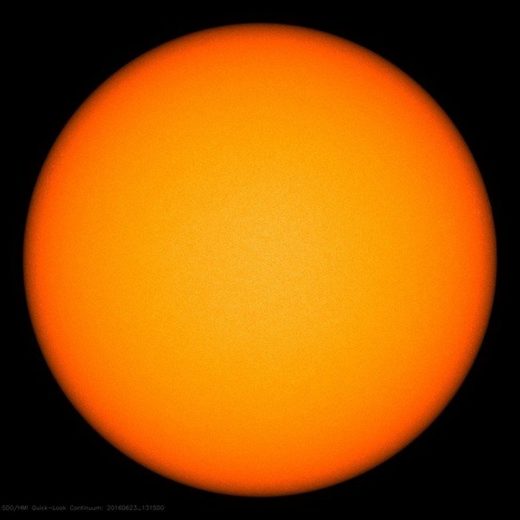
© NASAThe sun without any sunspots
Shivers! Yesterday, NASA images showed that the sun has gone "blank" without any sunspots for the fourth time this year. The solar surface shows complete inaction.
It could lead us to the Ice Age, say climate experts.
Usually, our sun doesn't have a pleasant face, but looks burning hot, pocked by sunspots. But now, it looks smooth, with sunspots at the lowest rate for 10,000 years.
Solar activity too has slowed down.
However, the sun's pleasant face isn't too pleasant for the earth. Such blank faces, without sunspot activity
could usher in a cold spell, just like the Maunder Minimum, which began in 1645 and went on till 1715. That was called the Little Ice Age and even became well-known because of the winter frost fairs that became popular on the frozen surface of the Thames.
The warning was issued by meteorologist and renowned sun-watcher Paul Dorian in his
report, which spread some tension: "
The blank sun is a sign that the next solar minimum is approaching and there will be an increasing number of spotless days over the next few years," said Dorian. "
At first, the blankness will stretch for just a few days at a time, then it'll continue for weeks at a time, and finally it should last for months at a time when the sunspot cycle reaches its nadir. The next solar minimum phase is expected to take place around 2019 or 2020."
Sunspot activity is like a pendulum, swinging back and forth within a period of 11 or 12 years. However,
solar activity is falling more rapidly than at any time in the last 10,000 years.
As
SpaceWeather put it: "
Right now the pendulum is swinging toward low sunspot numbers. Forecasters expect the cycle to hit rock bottom in 2019-2020. Between now and then, there will be lots of spotless suns. At first, the blank stretches will be measured in days; later in weeks and months. The current blank spell is the 4th such interval of 2016, so far."
Hence predictions - and these are not from astrologers but weathermen - forecast that more blank suns are likely. "
There will be lots of spotless suns," say the forecasters.
Last year, Professor Valentina Zharkov said that in the 2030s, the sun's activity could plunge by 60%, leading to the next mini Ice Age.
It would lead to crop failures as well as other disasters on the planet.
He said: "
I am absolutely confident in our research. It has a good mathematical background and reliable data, which has been handled correctly. In fact, our results can be repeated by any researchers with the similar data available in many solar observatories, so they can derive their own evidence of upcoming Maunder Minimum in solar magnetic field and activity."

That is the cycle. It expands to one based on 72 cycles (2 x 36) and one based on 108 cycles (3 x 36). That is why these are two of the most important sacred numbers. The event that is about to happen is a convergence of both of these larger cycles. All iterations of this cycle involve cold because they all involve the Sun going quiet in response to a decrease in plasma through at least this part of the galaxy. Some iterations are worse than others. This one is worse that Noah's flood (2345 BC). It is worse than the Venus event (1495 BC). This is far worse than what I now call the "Pythagorean" event that led to the rise of the Roman and Mayan (and still later the Inca) empires. This is the big show.
IT IS IMPORTANT TO REALIZE THAT WHEREVER YOU LIVE IT IS GOING TO GET MUCH COLDER IN THE COMING YEARS. GLOBAL WARMING IS THE BIG LIE OF THIS NEW FASCIST REGIME. THEY KNOW THE EXACT OPPOSITE IS TRUE.
Where I live there is no value placed on firewood. I am stockpiling it as fast as I can. You should do the same and add high efficiency wood burning stoves to all of your critical rooms.
BECAUSE ONE THING AND ONE THING ONLY IS ABSOLUTELY SURE. THESE EVENTS INVOLVE COLD.